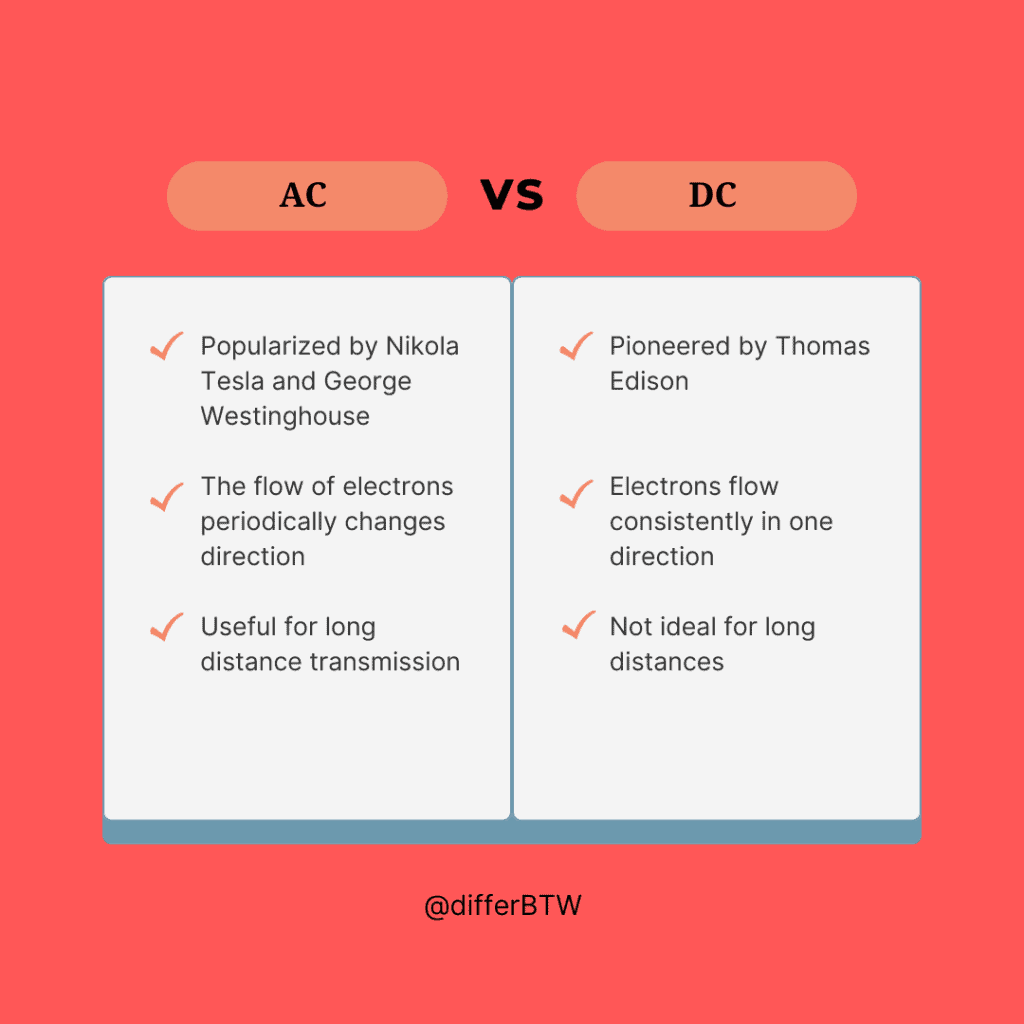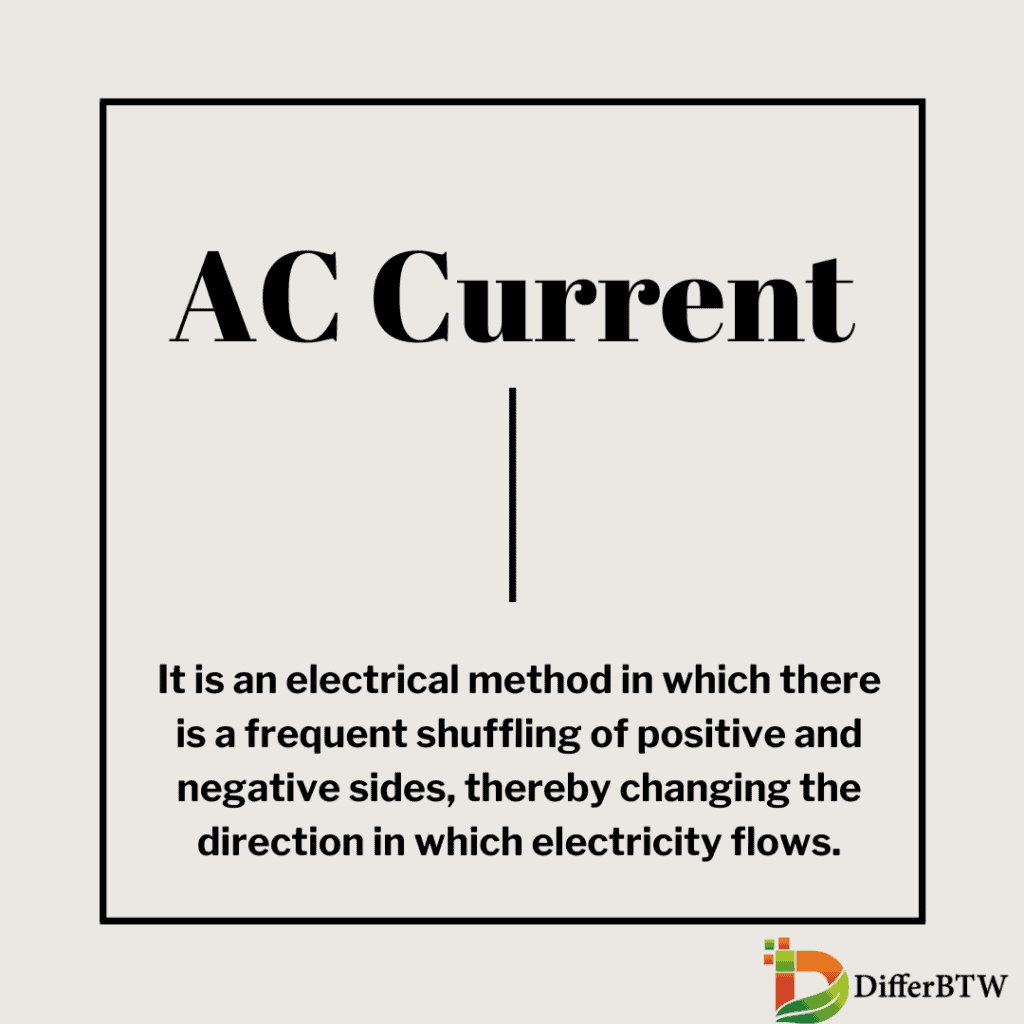AC (alternating current) and DC (direct current) are two fundamental types of electrical currents with distinct characteristics. AC current alternates direction periodically, rapidly changing its polarity over time, while DC current flows steadily in one direction. This key difference has significant implications for various applications.
AC current is used in household electricity and industrial power distribution due to its ability to be easily transformed and transmitted over long distances. DC current is prevalent in battery-powered devices and electronics, offering stable and consistent power flow.

Comparison Chart
| Parameter of Comparison | AC Current | DC Current |
|---|---|---|
| Flow Direction | Constantly reverses direction (back and forth) | Flows in one direction only (steady) |
| Frequency | Has a frequency (50 or 60 Hz) | No frequency (doesn’t change direction) |
| Source | Generators, power outlets | Batteries, solar cells, generators |
| Long Distance Travel | Great for transmitting power over long distances | Not ideal for long distances (loses power) |
| Applications | Powering homes, appliances, motors | Electronics, batteries, solar panels |
| Conversions | Needs a rectifier to convert to DC | Can be converted to AC using an inverter |
What is AC Current?
AC abbreviates “alternating current”. It is an electrical method in which there is a frequent shuffling of positive and negative sides, thereby changing the direction in which electricity flows. It is the most common way to deliver electricity from large-sized power plants to residential and commercial areas. When electricity travels in AC, the voltage keeps fluctuating.
A specially designed machine produces an alternating current called an alternator. This machine makes a current that changes its direction in a fixed time interval. The sole purpose behind producing AC is to supply electrical energy to large distances with much less power loss. The direction-change mechanism works when electrons change their movement.

Characteristics of AC Current
AC current possesses several key characteristics that distinguish it from DC current. Firstly, its periodic oscillation results in a constantly changing voltage polarity. This fluctuation allows AC power to be easily transformed and transmitted over long distances using transformers. Additionally, the frequency of AC current can vary depending on the application, with common frequencies ranging from 50 to 60 Hz in most electrical systems worldwide.
Advantages of AC Current
AC current offers numerous advantages in various electrical applications. One notable advantage is its ability to support efficient power transmission over long distances. The use of transformers enables voltage to be increased for transmission and then decreased for distribution, reducing power losses along the way. Furthermore, AC motors, widely used in industrial machinery and appliances, are more compact, cost-effective, and easier to control compared to their DC counterparts.
Applications of AC Current
AC current finds extensive use in diverse applications across different industries. In residential settings, it powers household appliances, lighting systems, and heating/cooling equipment. In commercial buildings, AC current is utilized for lighting, air conditioning, elevators, and other electrical systems. Moreover, AC motors drive various industrial machinery, such as pumps, compressors, and conveyor systems, due to their reliability and versatility.
Examples of Alternating Current (AC):
- Household Electricity: When you plug in your electronic devices or appliances at home, you’re likely using AC power. It’s what powers your lights, TVs, refrigerators, and pretty much everything else in your home.
- Power Grids: AC is the standard for power distribution across long distances. Power plants generate AC electricity, which then travels through transmission lines to reach homes and businesses.
- Electric Motors: Many appliances and machinery, such as washing machines, fans, and industrial equipment, use AC motors. These motors rely on the changing direction of the current to produce rotational motion.
- Fluorescent Lights: AC is used to power fluorescent lights found in offices, schools, and other commercial buildings. The rapid cycling of the current causes the phosphor coating inside the bulb to emit light.
- AC Generators: Devices like generators and alternators produce AC electricity. They’re used in backup power systems, vehicles, and renewable energy sources like wind turbines.
What is DC Current?
DC refers to “direct current”. The main characteristic of this current is that it flows in a linear direction, and its voltage remains constant throughout the supply. The most common DC power source is built-in and externally attached batteries. Until now, very few appliances use DC power except those that work on batteries.
Although many devices are now shifting to DC, the importance of AC is still unneglectable. Most importantly, DC is power used by mobile phones to take supplies from the battery or power banks. Electrical engineers are planning to use DC to supply electricity to long distances by using the HVDC transmission.
DC has so far shown excellent compatibility with the latest power generation mechanisms like solar and wind. DC is also reliable in terms of voltage supply because it provides constant voltage. In this way, it reduces the probability of damage to appliances in case of voltage fluctuation.

Characteristics and Properties
DC current has several distinguishing characteristics. Firstly, it maintains a constant polarity, meaning the positive and negative terminals remain consistent over time. This reliability makes DC power suitable for certain electronic devices, such as computers and telecommunications equipment, where stable voltage levels are crucial. Additionally, DC circuits are simpler to design and troubleshoot compared to AC circuits due to the absence of frequency variations and phase shifts.
Applications and Uses
DC current finds widespread applications across various industries. One of the most common uses is in powering electronic devices and appliances, including smartphones, laptops, and household electronics. Moreover, DC power is essential for charging batteries in electric vehicles, providing energy for off-grid solar installations, and driving motors in industrial machinery. Furthermore, certain specialized applications, such as electroplating and electrolysis, rely on DC current for precise control over chemical reactions.
Generation and Conversion
DC current can be generated using different methods, including chemical, mechanical, and photovoltaic processes. Chemical reactions within batteries produce DC electricity, while mechanical generators, such as dynamos, convert rotational motion into direct current. In addition, photovoltaic cells, known as solar panels, harness sunlight to generate DC power through the photovoltaic effect. Moreover, electronic devices called rectifiers are used to convert AC power from the grid into DC power for various applications.
Examples of Direct Current (DC):
- Batteries: Portable devices like smartphones, laptops, and flashlights rely on DC power from batteries. The current flows consistently in one direction, providing a stable source of energy.
- Solar Panels: Solar cells produce DC electricity from sunlight. This energy can be stored in batteries or converted into AC power using inverters for use in homes or businesses.
- Car Batteries: Automobiles use DC power from batteries to start the engine and power various systems like lights, radio, and air conditioning.
- Electrochemical Processes: DC is used in electroplating, electrolysis, and other electrochemical processes in industries like manufacturing and metal finishing.
- Electronic Devices: Many electronic gadgets, including computers, televisions, and music players, contain internal circuits that operate on DC power. Adapters and converters are used to convert AC power from outlets into DC power for these devices.
Difference Between AC Current and DC Current
Direction of Flow:
- AC (Alternating Current): The flow of electrons periodically changes direction, in a sinusoidal pattern. It’s like the ebb and flow of the tide, constantly reversing direction.
- DC (Direct Current): Electrons flow consistently in one direction, akin to a steady stream or a river flowing in a single direction without any reversals.
Generation:
- AC: Easily generated using alternators or generators, which rely on electromagnetic induction. This is the standard for most power grids worldwide.
- DC: Requires conversion from AC or specialized generators like solar panels or batteries. Historically, DC was the first form of electrical power used commercially by Edison.
Transmission:
- AC: Efficient for long-distance transmission over power lines, thanks to technologies like transformers which can step up voltage for reduced losses.
- DC: Becoming more popular for long-distance transmission due to advancements in high-voltage direct current (HVDC) technology, which minimizes power losses.
Voltage and Current Levels:
- AC: Voltage and current levels can be easily manipulated using transformers, making it adaptable for various applications.
- DC: Voltage levels are fixed, making it more suitable for specific applications like electronics where a stable voltage is required.
Safety:
- AC: Considered more dangerous at high voltages due to the potential for severe shocks and increased risk of electrocution.
- DC: Generally perceived as safer at lower voltages, although still poses risks, especially in high current situations like welding or battery charging.
Efficiency:
- AC: Efficiency can vary depending on factors such as distance of transmission, type of load, and voltage levels.
- DC: Generally more efficient for certain applications like electronics and renewable energy systems due to lower losses during conversion and transmission.
Use in Electronics:
- AC: Most household appliances and electronics require AC to operate, as it’s easily transformed to different voltages and currents.
- DC: Many electronic devices, especially portable ones like smartphones and laptops, utilize DC power internally. This is because batteries supply DC power, and converting AC to DC avoids the need for bulky transformers.
Historical Significance:
- AC: Popularized by Nikola Tesla and George Westinghouse during the War of Currents in the late 19th century, ultimately winning out over DC for widespread electrical distribution.
- DC: Pioneered by Thomas Edison and initially used for early electrical systems, but was eventually overshadowed by AC due to limitations in transmission distance.